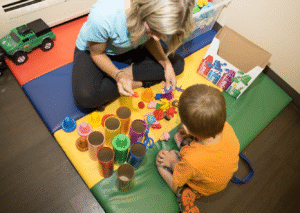
Physical therapy helps individuals improve strength, mobility, and function, especially those with developmental delays, neurological conditions, or physical disabilities. While traditional therapy can produce significant progress over time, intensive physical therapy (IPT) accelerates the achievement of therapy goals through frequent, focused sessions.
This blog explores what makes intensive physical therapy different, why it’s so effective, and how it can be especially beneficial for children and adults working toward specific milestones
What is Intensive Physical Therapy?
Intensive physical therapy involves higher-frequency sessions that occur several times per week, often lasting for a few hours each time, and can be coupled with occupational therapy for a longer, more intensive program regime. Rather than the typical one session per week, IPT is delivered in a condensed, structured manner over several weeks or months. This schedule allows patients to build skills through repetition, reinforcing progress and working towards their goals more quickly.
The Benefits of Intensive Physical Therapy
1. Accelerated Progress with Consistent Practice
Intensive physical therapy offers concentrated, repeated practice, essential for mastering physical skills and building muscle memory. Repetition strengthens neural pathways in the brain, helping the body learn and retain movements more efficiently. For patients, this consistent reinforcement translates to faster progress, whether they’re learning to walk, building core strength, or improving hand-eye coordination.
Example: A child learning to stand independently may initially struggle to maintain balance. Through IPT, with frequent practice and constant feedback, they can achieve balance faster than with traditional therapy.
2. Improved Motor Learning and Neuroplasticity
Intensive therapy taps into neuroplasticity, the brain’s ability to reorganize itself by forming new neural connections. This process is crucial for patients who have neurological conditions or developmental delays. Frequent, structured physical challenges in IPT encourage the brain to rewire and strengthen the connections needed to execute movements with increased ease.
Example: For children with cerebral palsy, IPT can enhance neuroplasticity by promoting improved motor control, enabling them to refine skills like grasping, reaching, or walking.
3. Goal-Oriented and Individualized Programs
A hallmark of IPT is the focus on individualized, goal-driven programs. Our therapists at Crawl Walk Jump Run Therapy Clinic design intensive sessions tailored to each patient’s specific milestones, from coordination to flexibility.
A special piece of equipment we use is the Universal Exercise Unit (UEU). The UEU helps to eliminate gravity and provides many different options for facilitation. In our clinic, we utilize the UEU for all disciplines and ages with activities varying from stretching and strengthening to standing, trunk control, and more.
It can be used in resistance training for strengthening specific muscles and also to position patients in ideal alignment that they would not be able to perform independently. This allows us to target muscles in different functional positions and provide repetition to change the brain’s neural connections.
Example: A teenager recovering from an injury may aim to return to sports. Through IPT, the therapy plan is adapted to the patients’ functional goals. The UEU can progressively introduce sports-specific exercises, gradually improving endurance and resilience through tiered and progressive resistance and weight-bearing capabilities.
4. Strengthened Muscles, Endurance, and Stamina
Increased frequency of sessions and use of specialized therapy equipment at Crawl Walk Jump Run Therapy Clinic provide more opportunities for exercises that build strength, stamina, and endurance. Since IPT often focuses on longer or more intensive sessions, it allows patients to condition their muscles, joints, and cardiovascular systems more effectively. This conditioning prepares the body for everyday activities and reduces the risk of injury by improving overall resilience.
Example: A child with low muscle tone might struggle with fatigue after short bursts of physical activity. IPT helps them build the stamina needed to participate in activities like running or playing without tiring quickly.
5. Motivating Environment and Therapeutic Support
With intensive therapy, patients and families benefit from a structured environment where progress is tracked frequently. This environment can be highly motivating, as patients see their hard work pay off more quickly than in traditional therapy settings. The sense of community and support fostered in IPT programs also encourages accountability and persistence.
Example: Young patients are often more enthusiastic about therapy when they experience frequent successes and see measurable changes, like achieving a higher jump or balancing independently.
Who Benefits Most from Intensive Physical Therapy?
Intensive physical therapy can be transformative for individuals with:
- Neurological Conditions: Conditions like cerebral palsy, spina bifida, or traumatic brain injuries respond well to IPT due to its impact on neuroplasticity and motor learning.
- Developmental Delays: Children with delayed motor skills can benefit from IPT’s repetitive nature, which reinforces movements and helps establish motor skills.
- Orthopedic Injuries: People recovering from surgeries or injuries can rebuild strength, regain flexibility, and restore movement with IPT.
Movement Disorders: Conditions like muscular dystrophy or multiple sclerosis require frequent practice to retain and improve physical function, making IPT an effective option.
IPT vs. Traditional Physical Therapy: What’s the Difference?
The primary difference between IPT and traditional therapy lies in the frequency and intensity of sessions. Traditional physical therapy is typically scheduled one to two times per week and can extend over a longer period, gradually working toward goals with regular but limited reinforcement.
Intensive physical therapy, on the other hand, offers a “boost” through its condensed, high-frequency approach, accelerating progress and targeting specific skill areas. With the specialized equipment at Crawl Walk Jump Run Therapy Clinic, we can target specific skills and muscles with graded exercises that meet you where you are.
The time-intensive nature of IPT may not be feasible for everyone, but for those able to commit, the benefits often far outweigh the challenges. We find this to be especially true in cases where significant milestones are critical for the patient’s quality of life.
Maximizing Intensive Physical Therapy at Home
While IPT occurs in a clinical setting, families and caregivers play an important role in maximizing progress by practicing skills at home. Here are some ways to reinforce gains made in IPT:
- Follow a Routine: Practice skills at the same time every day to build consistency and familiarity. Routines also help children and adults incorporate therapeutic exercises into daily life.
- Use Adaptive Equipment: If recommended by your therapist, adaptive equipment like walkers, braces, or seating supports can make it easier to practice exercises safely and comfortably.
- Create a Supportive Environment: A space where patients feel encouraged and motivated is essential. Positive reinforcement and praise go a long way in building confidence and helping patients persevere through challenges.
Making the Commitment to Intensive Physical Therapy
For families, the decision to pursue IPT often requires balancing therapy needs with other daily responsibilities. The commitment of time and energy can be substantial, but the outcomes achieved through IPT can be life-changing. Many families find that the short-term investment in IPT translates into long-term gains, such as achieving independence in daily tasks, improving overall health, and reducing the likelihood of future complications.
If you’re considering intensive therapy, please contact our clinic and schedule a free consultation with a licensed physical therapist. Together, we can create a structured, goal-oriented plan that targets the skills and milestones your child needs to reach their full potential.



